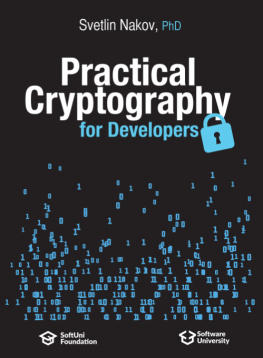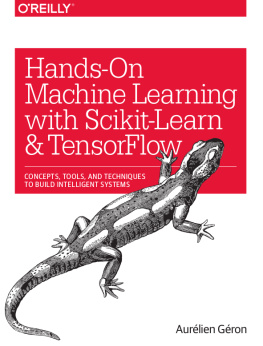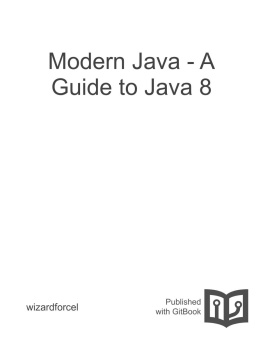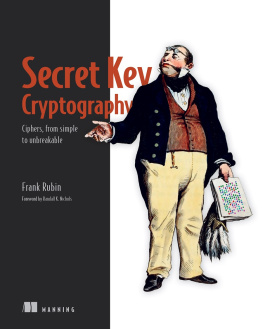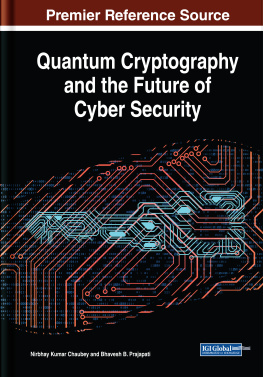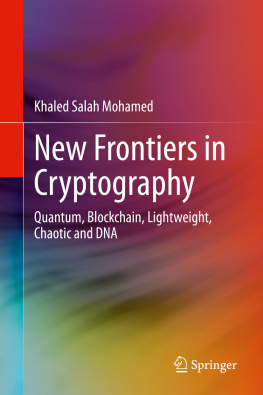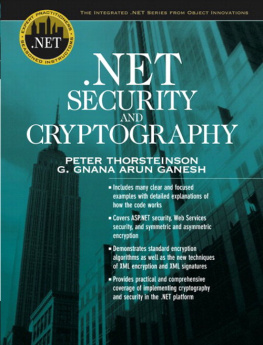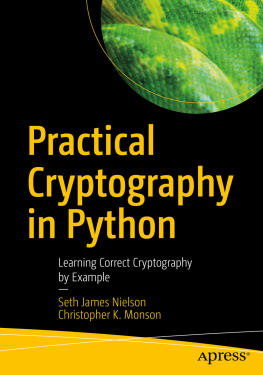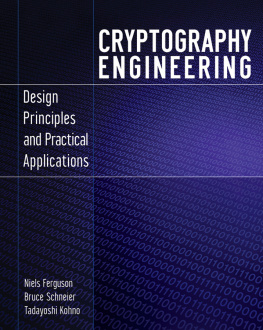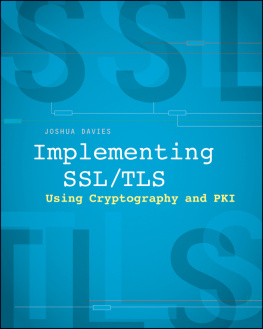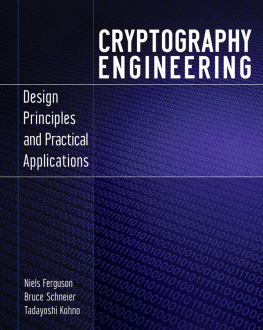it-ebooks - Practical Cryptography for Developers
Here you can read online it-ebooks - Practical Cryptography for Developers full text of the book (entire story) in english for free. Download pdf and epub, get meaning, cover and reviews about this ebook. year: 2019, publisher: iBooker it-ebooks, genre: Home and family. Description of the work, (preface) as well as reviews are available. Best literature library LitArk.com created for fans of good reading and offers a wide selection of genres:
Romance novel
Science fiction
Adventure
Detective
Science
History
Home and family
Prose
Art
Politics
Computer
Non-fiction
Religion
Business
Children
Humor
Choose a favorite category and find really read worthwhile books. Enjoy immersion in the world of imagination, feel the emotions of the characters or learn something new for yourself, make an fascinating discovery.
- Book:Practical Cryptography for Developers
- Author:
- Publisher:iBooker it-ebooks
- Genre:
- Year:2019
- Rating:4 / 5
- Favourites:Add to favourites
- Your mark:
- 80
- 1
- 2
- 3
- 4
- 5
Practical Cryptography for Developers: summary, description and annotation
We offer to read an annotation, description, summary or preface (depends on what the author of the book "Practical Cryptography for Developers" wrote himself). If you haven't found the necessary information about the book — write in the comments, we will try to find it.
Practical Cryptography for Developers — read online for free the complete book (whole text) full work
Below is the text of the book, divided by pages. System saving the place of the last page read, allows you to conveniently read the book "Practical Cryptography for Developers" online for free, without having to search again every time where you left off. Put a bookmark, and you can go to the page where you finished reading at any time.
Font size:
Interval:
Bookmark:
- 1.1
- 1.2
- 1.3
- 1.4
- 1.4.1
- 1.4.2
- 1.4.3
- 1.4.4
- 1.4.5
- 1.4.6
- 1.5
- 1.5.1
- 1.5.2
- 1.5.3
- 1.5.4
- 1.5.5
- 1.5.6
- 1.5.7
- 1.5.8
- 1.5.9
- 1.5.10
- 1.5.11
- 1.5.12
- 1.6
- 1.6.1
- 1.6.2
- 1.6.3
- 1.7
- 1.7.1
- 1.7.2
- 1.7.3
- 1.8
- 1.9
- 1.9.1
- 1.9.2
- 1.9.3
- 1.9.4
- 1.9.5
- 1.9.6
- 1.9.7
- 1.9.8
- 1.10
- 1.10.1
- 1.10.2
- 1.10.3
- 1.10.4
- 1.10.5
- 1.10.6
- 1.10.7
- 1.10.8
- 1.10.9
- 1.10.10
- 1.10.11
- 1.11
- 1.11.1
- 1.11.2
- 1.11.3
- 1.11.4
- 1.11.5
- 1.11.6
- 1.11.7
- 1.11.8
- 1.11.9
- 1.12
- 1.12.1
- 1.12.2
- 1.12.3
- 1.13
- 1.13.1
- 1.13.2
- 1.13.3
- 1.14
- 1.14.1
- 1.14.2
- 1.14.3
- 1.14.4
- 1.15
The Advanced Encryption Standard (AES) cipher, also known as "Rijndael" is a popular, secure, widely used symmetric key block cipher algorithm, used officially as recommended encryption technology standard in the United States. AES operates using block size of 128 bits and symmetric keys of length , , , and bits.
The AES symmetric encryption algorithm is considered highly secure (when configured correctly) and no significant practical attacks are known for AES in its history.
AES is used internally by the most Internet Web sites today for serving https:// content as part of the TLS (Transport Layer Security) and SSL (Secure Sockets Layer) standards for secure host to host communication on the Web.
Due to its wide use in the Internet secure communication, modern CPU hardware implements AES instructions at the microprocessor level to speed-up the AES encryption and decryption.
The AES algorithm can operate with different key lengths, but the block size is always 128 bits. For most application 128-bit AES encryption (AES-128) is enough, but for higher encryption level, it is recommended to use AES-256 (256-bit key length).
Like any other block ciphers, AES can use one of several modes of operation (CBC, ECB, CTR, ) to allow encryption of data of arbitrary length. The recommended mode for the general case and for encrypting blockchain wallets is "CTR".
Most modes of operation require an initial vector (IV). When using a counter mode (CTR), i.e. AES-128-CTR (128-bit) or AES-256-CTR (256-bit) for example, first a non-secret random salt (IV) should be generated and saved along with the encrypted ciphertext output. The size of the IV is always the same as the size of the block, i.e. 128 bits (16 bytes).
The AES encryption, combined with CTR block mode and random IV causes the encryption algorithm to produce different encrypted ciphertext each time, when the same input data is encrypted. This ensures that nobody can construct a dictionary to reverse back the encrypted ciphertext.
AES encryption in CBC mode uses a padding algorithm (like PKCS7 or ANSI X.923) to help splitting the input data into blocks of fixed block-size (e.g. 128 bits) before passing the blocks to the AES-CBC algorithm. Most developers use the CTR mode of operation for AES, so they don't need padding.
Without using a block mode, the ciphertext, generated by the AES algorithm is exactly 128 bits (16 bytes), just like the block size. The input data is also exactly 128 bits.
The ciphertext, generated by the AES-CTR algorithm (AES in CTR cipher block mode) has the same size like the size of the input data. No padding is required.
The ciphertext, generated by the AES-CBC algorithm (AES in CBC ciphertext mode), has size of 128 bits (16 bytes) or multiple of 128 bits. The input data should be padded before encryption and unpadded after decryption.
The AES algorithm often is used along with a password-to-key derivation function, e.g. Scrypt(passwd) -> key or PBKDF2(passwd) -> key.
The AES algorithm may use MAC (message authentication code) to check the password validity, e.g. HMAC(text, key).
The MAC code is typically integrated (see the concept of integrated encryption) in the algorithm's output. It is calculated from the input message, together with the encryption key. From the calculated MAC, it is impossible to reveal the input message or the key, so the MAC itself is not a secret. Some block cipher modes (like AES-GCM) integrate message authentication in the obtained ciphertext as part of their work, so you don't need to add MAC explicitly.
Typically MAC is calculated and used like this:
- Before the encryption, the MAC is calculated as:
mac = HMAC-SHA256(input_msg, key). - The input data is encrypted and the ciphertext is stored along with the random salt (IV) and the MAC.
- After decryption, the MAC is calculated again and is compared with the MAC stored along with the encrypted message.
- If the MAC is the same, the decryption is successful: correct ciphertext + decryption key + algorithms settings (IV, block mode, padding algorithm).
- If the MAC is different, the decryption is not successful: incorrect key / password or broken ciphertext, incorrect MAC or different algorithms settings (IV, block mode, padding, etc.)
The MAC can be calculated and verified using several approaches to integrated encryption: Encrypt-then-MAC, Encrypt-and-MAC, MAC-then-Encrypt.
The entire AES encryption process (password-based authenticated encryption) looks like this:
Algorithm parameters are selected (e.g. AES, 128-bit, CTR mode + Scrypt + Scrypt parameters + MAC algorithm). These parameters can be hard-coded in the AES algorithm implementation source code or can be specified as input for the AES encrypt and decrypt. Always use the same parameters for encryption and decryption.
The encryption key is derived from the encryption password using a key-derivation function (KDF), e.g. Scrypt
Font size:
Interval:
Bookmark:
Similar books «Practical Cryptography for Developers»
Look at similar books to Practical Cryptography for Developers. We have selected literature similar in name and meaning in the hope of providing readers with more options to find new, interesting, not yet read works.
Discussion, reviews of the book Practical Cryptography for Developers and just readers' own opinions. Leave your comments, write what you think about the work, its meaning or the main characters. Specify what exactly you liked and what you didn't like, and why you think so.

